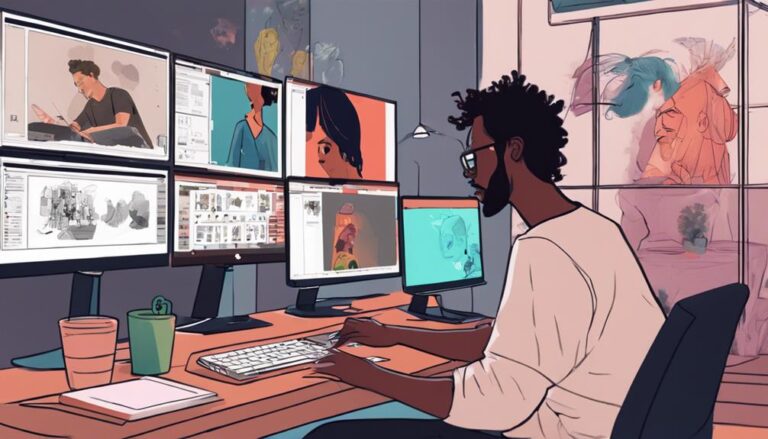5 Proportion Tips for Believable Cartoon Characters
As you sit down to design a cartoon character, you're likely enthusiastic to bring your imagination to life. But before you start sketching, consider this: proportion is the unsung hero of believable character design. It's the secret to creating a character that's both visually appealing and relatable. By striking a balance between exaggeration and realism, you can craft a character that resonates with audiences. But how do you achieve this balance? That's where these five proportion tips come in – and by applying them, you'll be well on your way to creating a character that's both memorable and authentic.
Key Takeaways
- Balance exaggerated features with realistic proportions to create a believable cartoon character.
- Consider the character's age when determining physical proportions and overall aesthetic.
- Use reference points to ensure visual harmony and balance in the character's design.
- Consistency in facial features, line weight, texture, and color palette is crucial for a cohesive look.
Balance Exaggeration With Realism
When conjuring up a cartoon character, you're constantly juggling two opposing forces: the need to exaggerate features for comedic effect and the importance of grounding your design in enough realism to make it relatable.
It's a delicate balance, but one that's vital for creating a character that's both humorous and endearing.
To achieve this balance, focus on creating dynamic ranges in your character's design. This means exaggerating certain features, like oversized eyes or ears, while keeping others more realistic.
For example, you might give your character enormous, expressive eyebrows that can convey a range of emotions, but keep their facial structure relatively proportional.
This contrast between the absurd and the realistic will create a visually appealing and engaging character.
Additionally, don't forget to ponder expressive anatomy, like the way your character's body language and posture can convey their personality.
Consider the Character's Age
As you're conjuring up the perfect balance of exaggeration and realism, don't forget that your character's age can be a major factor in determining their physical proportions and overall aesthetic.
A kid's character, for instance, should have childlike features that scream 'I'm young and full of energy!' Think big eyes, chubby cheeks, and a tiny nose.
Their youthful proportions should be accentuated, with shorter limbs and a rounder body shape that's reminiscent of a ball of playdough.
On the other hand, an older character might've more refined features, with a longer face, more defined facial structures, and a more mature body type.
Don't be afraid to exaggerate these differences to make your character stand out.
Remember, the key is to make your character's age believable without making them look like a realistic human.
You're drawing a cartoon, after all! So, have fun with it and experiment with different proportions until you find the perfect fit for your character.
Pay Attention to Body Shape
What kind of body shape will help your character's personality pop, and make their movements and actions look like an extension of who they are? It's time to think beyond the typical 'tall and lean' or 'short and round' archetypes. Consider the body type that will amplify your character's traits and quirks.
Muscle structure matters: A character with a athletic build will naturally move with more confidence and energy, while a character with a softer physique might be more clumsy or awkward.
Body proportions can be exaggerated: Take a trait and blow it up to comical proportions. For example, if your character is a bit of a airhead, give them a disproportionately large head to match their goofy personality.
Consider the character's lifestyle: If your character is a couch potato, they might've a more rounded body shape to reflect their sedentary lifestyle.
Don't be afraid to break the rules: Cartoon characters don't have to follow real-world physics or anatomy. Feel free to experiment and create a body shape that's truly unique and memorable.
Use Reference Points Wisely
By anchoring your character's design to a few well-chosen reference points, you can create a sense of visual harmony and balance that lets their personality shine through.
Think of it like building a house: you need solid foundations to support the quirky roof and crazy chimney that make your character unique.
Measuring proportions is key – you don't want your hero's head to be the size of a pea or their arms to be longer than their legs! Use anatomical accuracy as your guide, but don't be afraid to exaggerate or distort features to fit your character's personality.
For example, a happy-go-lucky hero might've oversized eyes and a toothy grin, while a brooding villain might've a pointed chin and razor-sharp cheekbones.
By choosing reference points that work for your character, you can create a sense of authenticity that makes them feel more real and relatable.
Just remember, it's all about balance – too many reference points and your character starts to feel like a Frankenstein's monster of mismatched parts!
Consistency Is Key Factor
When you're building a cartoon character, consistency is the glue that holds their design together, so make sure you're not mixing and matching features like they're at a costume party. You want your character to look like they belong in the same world, not like they raided a thrift store and put together a mishmash of styles.
To achieve this consistency, focus on creating a visual hierarchy in your design. This means deciding what elements are most important and making sure they stand out.
Certify your character's facial features are cohesive in style and proportion.
Use a consistent line weight and texture throughout the design.
Establish a clear color palette and stick to it.
Make sure the level of detail is consistent across the character's entire body.
Frequently Asked Questions
How Do I Determine the Best Proportion for a Fantasy Creature?
When crafting mythic hybrids, you're not bound by real-world rules, so don't be afraid to experiment with fantastical anatomy! You'll determine the best proportion by asking yourself what's most believable – and hilarious – in this wacky, wonderful world you're creating.
Can I Use Real-Life Animals as Reference for Cartoon Animals?
You can totally use real-life animals as reference for cartoon animals, but don't get too caught up in animal accuracy – it's cartoonish flair you're after! Species selection is key, so choose ones that spark your creativity and inspire wild, wacky adaptations.
What Is the Ideal Head-To-Body Ratio for a Child Character?
When designing a child character, you'll want to nail that head-to-body ratio, evoking childhood nostalgia while achieving ageless design. Aim for a 1:3 to 1:4 ratio, making those big, round eyes and chubby cheeks undeniably adorable!
How Do I Ensure Consistency Across Different Character Poses?
'When posing your characters, you're aiming for flexibility, not freaky contortionism! Establish flexibility guidelines and dynamic ranges for each joint to guarantee consistency across poses – and avoid those creepy, unnatural twists!'
Are There Any Specific Proportion Rules for Comedic Characters?
When creating comedic characters, you'll want to amplify their features for laughs, think exaggerated noses, bulging eyes, and wacky hairdos! Comedic silhouettes should be quirky, irregular, and full of visual interest, making your characters truly unforgettable and hilarious.
Conclusion
Now, remember, proportion is like the secret sauce that makes your creation go from meh to mesmerizing.
By balancing exaggeration with realism, considering age and body shape, using reference points wisely, and maintaining consistency, you'll craft a character that's both believable and bursting with personality.
So, go ahead, get creative, and don't be afraid to bend the rules – after all, cartoons are all about having fun!







